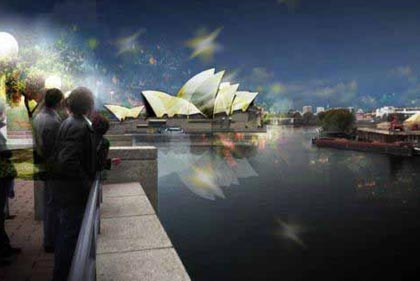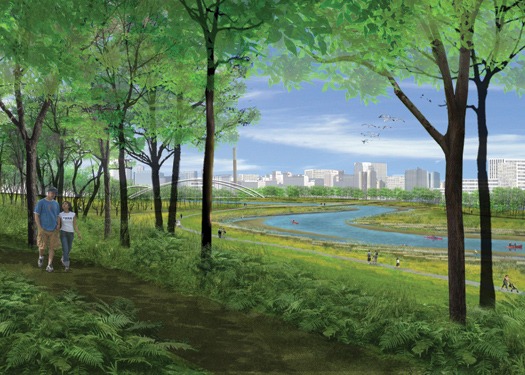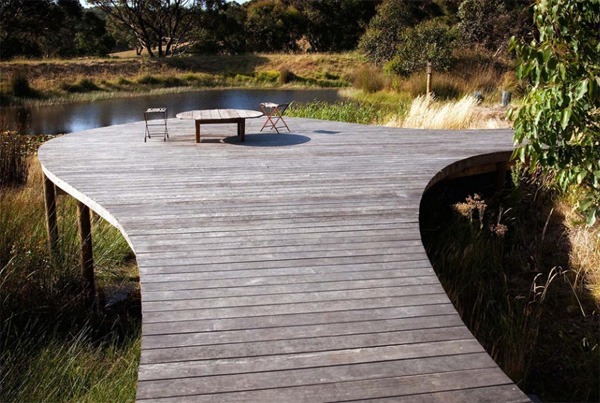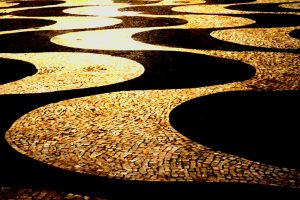The freeway for the electric and hybrid car need not be the highway we are used to.There is no reason why it might not be encased in landscape when the view out is less than appealing: concrete noise barriers or the back of suburban areas or some of the more hostile industrial areas of our large cities.There is no reason why the drive to work need be monotonous…and why the landscape views might not be considered in the same way as a promenade through a garden. We should take advantage of what nature provides and the cultural landscapes we have created.
Tag Archives: landscape design
Just around the Corner
The Architectural Association in describing ‘Landscape Urbanism’ says what Landscape it is not. It is NOT:
“…understood as a scenographic art, beautifying, greening or naturalising the city.”
And then what it IS;
“…scalar and temporal operations through which the urban is conceived and engaged with.”
Thus, Landscape Urbanism prioritises the phenomenological experience of the city, while distancing itself (perhaps defensively) from the visual aesthetic. Perhaps an ironcial realisation of this preference for the non-aesthetic is the prediction by James Corner of the disappearance of the city into the landscape. Perhaps this prophecy will be realised quite differently than the romantic post-industrial ruin? Corner, typified by the high line project, focuses on the rehabilitation of the abandoned elements of the city and post-industrial landscape.Can landscape urbanism be artfully conceived?
Perhaps the city of the future will afterall disappear under the advance of the landscape, but once again capture something of the beauty which is now itself abandoned by its favourite profession?
In search of Sustainable Gardens…
So what is the sustainable aesthetic about? I suggest a few characteristics might be common to the sustainable garden aesthetic:
* mimicking nature
* minimal interference with the landscape
* native plant selection
* eco-material selection ie timber and stone
* bushland settings
* curved lines
* low water, low chemical and low maintenance
* absence of paths, boundary fences and made roads
For a garden see: http://www.e-ga.com.au
For a plant aesthetic see: http://www.flickr.com/photos/42478440@N00/517961141
For an idea of how art & sustainability (green design) might have a more dramatic relationship also see the El Molino garden, a blend of formalism and naturalism http://www.anthonyexter.com/gardens/el_molino/2.php which possibly focuses on reduced resource use (water and energy) and plant selection , rather than a strictly natural aesthetic in the form, layout and background to the scheme.
Seine it before?
 If the Parisian plan to build a replica of the Sydney Opera House goes ahead half the world will be able to save their airfare to Australia and visit the Opera House and the Effiel Tower simultaneously. Perhaps Sydney need only build an Effiel Tower on the harbour and Australians will have no need of a trip to Paris?
If the Parisian plan to build a replica of the Sydney Opera House goes ahead half the world will be able to save their airfare to Australia and visit the Opera House and the Effiel Tower simultaneously. Perhaps Sydney need only build an Effiel Tower on the harbour and Australians will have no need of a trip to Paris?
Still, the Opera House undeniably looks good wherever you build it. You can’t blame the Parisians for their good taste!
Perhaps an enterprising young Australian or Danish architect will suggest to the French that they can come up with an original design that will do for the Seine River what the Opera House has done for the harbour in Sydney…..
The city of Graz in Austria has made a low-key addition to the River Mur. While the Brazilian architects Architectum have designed a mobile gallery for the Thames.
As for landscape design? Well tree-lined rivers are not always a priority.
Living with green and blue
What is the future of water architecture? [ http://wiki.provisionslibrary.org/blog/index.php/2008/02/06/water-architecture-a-floating-alternative-for-the-future/ ] Surely it is zen. http://www.whatsonyourplate.msstate.edu/architecture/water.html Or…. http://www.cmoa.org/exhibitions/popup/diller.html
Corbusier’s influence continues to inspire and to produce some of the most evocative architecture sensitive to its landscape setting. The building does not dominate the landscape, rather the landscape is both shield and platform. Garden is both formal and informal. http://www.archdaily.com/374/os-house-nolaster/
Roberto Burle Marx as a context-sensitive designer
As a painter, Roberto Burle Marx was an international abstract expressionist. But as a garden designer and landscape architect he showed a high degree of sensitivity to context – I say ‘surprising’ only because I was so slow to appreciate the complexity of this point. His planting was voluptuously Brazilian, like his mother, and Marx could see no reason for using European plants. Nor did he see any reason for the hard detailing to draw inspiration from the land of his father: Germany. Instead, he drew upon the country whose language is spoken in Brazil. The accompanying photograph is of Copacabana Beach – but could just as well have been taken in Portugal. Until I went to Portugal, I thought this amazing design was an example of Burle Marx inventiveness as an abstract painter. I was very wrong.






